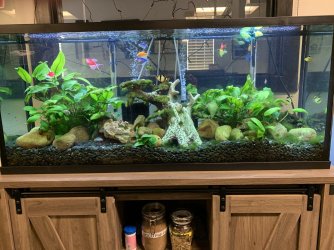Today. I changed roughly 60 percent of the tank water in a 55, 60, 100 and 300 gallon tanks. If you do the math, that comes to about 395 gallons of water. If I lived any other place but Colorado, using that much water would be pretty costly. But, here my water bill seems to be next to nothing no matter how much I use. I did notice that the highest mountain range just west of us got quite a bit of snow. The foothills near them are still clear. Last year we received quite a bit of snow, so that's probably why my water bill is so low. Typically, I change the water in all my tanks from Monday through Thursday. The tank I manage gets a large water change twice weekly. I've noticed the sponge filters don't need to be squeezed out very often if I'm always removing and replacing most of the water every week. So, the fish get near pure water conditions and I don't have to do as much.
10
10



